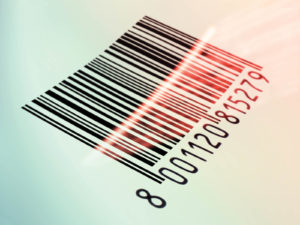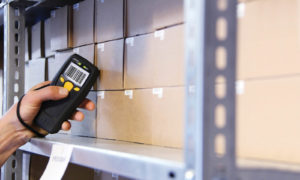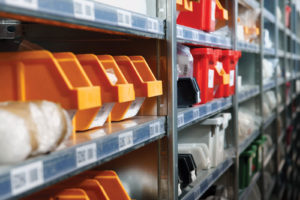Taking stock
 Fabricators’ inventory management needs vary from simple to complex.
Fabricators’ inventory management needs vary from simple to complex.
A customer contacts your shop for a new bimini top for his boat. He meets with you at your business, choosing an ever-popular canvas from your selections. After he provides a down payment,
you enter his order into your project management system and initiate the production process. The next day, you discover that you don’t have enough yardage of the requested fabric. The reason? An employee neglected to note that the stock was running low on this fabric. Now you need to reorder the fabric, and your projected completion time is delayed on this customer’s order. Sound familiar?
Marine fabrication shops, both large and small, grapple with inventory management. Keeping track of production supplies—including popular zippers, standard grommets, and go-to fabrics—is paramount.
Necessity, the mother of invention
Just ask Justin Jones, founder of Sewlong—Custom Covers in Salt Lake City, Utah. Jones developed inTex software to handle his growing company’s needs.
As Jones explains, the software was born out of necessity. “Over the years I haven’t found any great solutions. A lot of people use QuickBooks, but that didn’t seem the perfect fit for us, so I developed a package specifically for marine fabricator shops,” Jones says.
While inventory management wasn’t the main focus of Jones’s software development, it has resulted in a robust program that handles a multitude of issues for a typical marine fabrication shop.
“Our biggest challenge is production management and keeping track of all of the details for each custom job,” Jones says. “For example, one customer wants green thread, another wants blue fabric, this guy wants black snaps, and so we need to keep track of all of those material details and also the inventory levels related to these specific requests.”
While searching for the perfect solution, Jones experimented with different customer relationship management (CRM) systems. However, he found these CRM systems far too rigid—forcing him to change his business practices to accommodate the software.
“I couldn’t find a solution that really worked specifically for a marine fabrication shop’s needs,” Jones says. After seven years of development and testing, inTex, a cross-platform solution, was born and refined. Its third generation will officially launch in January 2017 to meet the needs of marine fabricators.
“By combining deep industry knowledge with excellent developers, we have designed a cross-platform software solution that is powerful, adaptable and built specifically for marine canvas shops,” Jones says.

Tablets offer convenient options for employees who work directly with inventory management software.
Finding the right balance
In simple terms, inventory control is the oversight of a company’s stock. For marine fabricators, that means having a consistent awareness of the essential materials for production processes. These materials might be fabric, thread, grommets, window supplies or particular components needed for a shop’s specialty work. Controlling and managing inventory provides the right balance of stock in your shop or warehouse, allowing you to complete custom projects efficiently.
In a broader sense, inventory control encompasses the management of operations, logistics and supply chains. Where your company stands on inventory management can tell a lot about your business strengths or, potentially, your weaknesses. Of course, for small or even one-person shops, inventory management can be a simplified process, but it should be a process nonetheless. That’s because fabricators depend on having the right materials on hand when they need them.
Doing a poor job at inventory management can have a ripple effect on a business. A company that lacks control over inventory may be caught short of stock, leading to inefficient workers, lost sales opportunities and disappointed customers. In addition, you may end up with an overabundance of certain items and even obsolete components, both of which inflate storage costs and dampen profitability.
“Most people use QuickBooks for inventory management within the marine fabrication industry, but QuickBooks is really not designed for inventory type management. QuickBooks is great for a situation such as ‘buy a product, sell a product.’ But when marine fabricators are buying all sorts of components, adding labor tasks and consolidating those efforts, QuickBooks simply can’t handle this type of need,” Jones says.
One big piece of the puzzle is having better control of your inventory management on a per project basis—what you are estimating vs. what you actually use and what you actually have on hand. If you estimate five yards to do a particular boat cover, but in reality the job will require six yards, the appropriate software should help you look back and see if you are over- or underestimating.
“Again, when you go to start a job and go to our computer and see what you physically have on hand in your shop, there’s a real benefit to that, especially as your shop or business grows,” Jones says. “For those owners who are a one-man shop, visually looking on a shelf to see what you have on hand may work. But for large shops, especially those with employees, having a centralized inventory management system that alerts you when you need to order components is vital.”
Most marine fabricators look at their inventory daily or on a project-by-project basis. When they see components are limited, they reorder.
When physically managing their inventory, one method that Sewlong uses, because of space constraints, is putting surplus of a component in a different area of their shop. So if a bin is holding a particular type of grommet, for example, at the bottom of that bin they will put a yellow sheet of paper that indicates surplus grommets are being housed in a different part of the shop.
“The computer may tell a person there are more of that component, but they don’t see more in the box. That sheet of paper tells them that they can find more in storage somewhere else,” Jones says. “That is a physical thing that we do to let our team know that there is more stock somewhere else.”
 Everyone on board
Everyone on board
It is essential that employees and production teams be accountable and pay attention to inventory processes.
“When they [employees] use the last count of thread, they need to make sure the computer is telling them that it is the last of the thread and we need to order more,” Jones says. “There are benchmarks that they need to look for, that the computer will indicate, such as we are down to one case of something. So getting the team to buy into it is the biggest challenge of them all.”
Sewlong has terminals in their shop, and the software Jones developed is iPad friendly, allowing his team to be on top of the inventory constantly.
The industry trend is that there are fewer shops, doing more work within the marine fabrication business. The shops are getting bigger, with more production-oriented shops.
“Everyone in the industry seems to be focusing heavily on automation, including automated cutting tables and measuring,” Jones says. “While they are doing things better as a result, everyone has kind of ignored the production and inventory management components. When we go to some of the industry shows and we learn about all of the different automation products, I say, ‘Wow, that’s great, but how do you keep track of your orders?’ And they respond, ‘We use these triplicate order forms.’ I have to chuckle because they are focused so hard on the production, but when it comes to keeping track of the inventory, keeping track of the jobs and the detail for the jobs, everyone is really in the dark ages.”
Ultimately, the more automated your system is, the less paperwork there will be. And while there are a whole host of inventory management systems out there, few meet the unique needs of marine fabricators. Some programs are designed to track the location of an item within the warehouse, which helps when it’s time for production. Other systems may utilize barcode scanners that will communicate with other devices to help you track inventory or even the status of a project.
 Simple, yet effective
Simple, yet effective
As the owner of a one-person shop, Faith Roberts, IMF, MFC, of Banner Canvas in Ham Lake, Minn., recognizes that, regardless of whether you use your inventory management software or a visual inventory system, it’s important to determine appropriate quantities to have on the shelf and set a schedule for ordering.
Roberts relies on QuickBooks for Manufacturers, which is altered and provides more of an indepth look at each project’s production process. In the near future, she will also be evaluating Microsoft OneNote, to help her manage the details for all of her project management needs.
“My inventory system is generally not on QuickBooks. A lot of conferences and conventions that I attend address how to use QuickBooks as an inventory tool, but downloading the information is the drawback, as I just don’t have time,” Roberts says. “After 30 years, I’m very old-school. I pretty much know what I have. I am extremely organized with labeled bins categorized in sections. I can look at my shelves and know exactly what I have. My strategy has developed simply because of the lack of software available.”
Roberts recognizes that if she had employees, a computerized inventory system would be required because of the multiple people accessing her shop’s inventory.
“Even as a one-person shop, it is still probably appropriate for me to have a computerized inventory system, because it would allow me to be able to determine the cost of my inventory rather than taking a wild guess at it,” Roberts says.
While some company managers say having a well-organized computerized inventory management system in place helps to better track products and their usage, others are comfortable in their well-defined simpler tracking processes. One basic way is to create a spreadsheet with various columns for product name, item number, and quantity. You can have a column to deduct what you use in your production processes. You can also keep a log of new incoming stock.
Of course, this can be a labor-intensive process that business owners may not trust, because it requires continuous manual monitoring to ensure that inventory pieces are accounted for. The information is difficult to share and track, and human error can result in inaccurate inventory numbers.
Mike Charpentier, manager at Paul’s Custom Canvas in Denver, Colo., keeps track of their inventory with an Excel spreadsheet, looking at the inventory spreadsheet daily in the summer and less frequently in the winter months.
“In our busy season we look to turn boats quickly,” Charpentier says. “If we don’t have what we need in stock, it slows the whole process. While you would have more inventory on hand for large manufacturers, smaller manufacturers still have to think ahead and have what they need. We are not using any technology to track inventory. We could have four or five bimini tops come in in one day, and we just know what we will use and know to reorder before we have a problem.”
The team at Paul’s Custom Canvas tries to keep their inventory management as simple as possible by having one or two employees handle the stock duties.
“This helps keep mistakes to a minimum,” Charpentier says. “We try to make it so we are not wondering if you ordered the hardware or if I need to or did we double order.”
Charpentier says their shop would have a hard time going to a computerized system. “We find that we give a lot of small freebies to keep customers that just spent a lot of money with us. It is hard to charge them for small things and this would be hard to track,” Charpentier says. “I also think with our business, we have to be able to see what is coming in and have the inventory ready to use. I’m not sure how that would work if something didn’t get ordered until it was low in inventory. We have talked a lot about how to streamline inventory; we feel that as of now what we do works best. I would not be opposed to a new system; it just needs to be proven to me that it works.”
Maura Keller is a freelance writer based in Plymouth, Minn.
 TEXTILES.ORG
TEXTILES.ORG 






